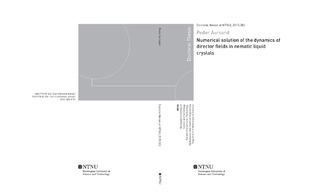| dc.contributor.author | Aursand, Peder | |
| dc.date.accessioned | 2016-01-27T09:05:24Z | |
| dc.date.available | 2016-01-27T09:05:24Z | |
| dc.date.issued | 2015 | |
| dc.identifier.isbn | 978-82-326-1263-5 | |
| dc.identifier.issn | 1503-8181 | |
| dc.identifier.uri | http://hdl.handle.net/11250/2374944 | |
| dc.description.abstract | Since their discovery in the late 1800s, liquid crystals have become an important
part of the technology of the modern world. As a consequence the
study of anisotropic liquids in general, and liquid crystals in particular, has
grown into a large interdisciplinary field involving physics, mathematics,
chemistry and biology to name a few.
In a series of papers we consider numerical solution of the evolution of
the director, a vector valued field giving the local average orientation of the
long axis of molecules in nematic liquid crystals. The flow field is assumed
to be stationary throughout this work. We consider both the free elastic
dynamics of the director as well as the case with applied electric fields on a
finite domain.
We study the dynamics of the 1D Fréedericksz transition, where an
applied electric field forces reorientation in the director field. The director
is assumed strongly anchored and the boundaries. Herein, we study the
role of inertia and dissipation on the time evolution of the director eld
during the reorientation. In particular, we show through simulations that
inertia will introduce standing waves that might e
ect transition time of
the reorientation, but only for very small time scales or extremely high
molecular inertia.
The Fréedericksz transition is also numerically studied with weak boundary
anchoring. For this problem it has been shown analytically that there
exists a hierarchy of meta-stable equilibrium con gurations. This is in sharp
contrast to the strongly anchored case, where the equilibrium is globally well
defined. We derive an implicit numerical scheme for this problem and show
the well-posedness of the discrete equation system. The method can be
used for the fully nonlinear model with coupled electric field. Through simulations
we show that the director can transition into different meta-stable
states given different small perturbations to the initial data.
The numerical solution of variational wave equations describing the elastic
dynamics of nematic liquid crystals is considered in both 1D and 2D.
Using energy respecting Runge{Kutta Discontinuous Galerkin methods we
show that numerical solutions that either conserve or dissipate a discrete
version of the energy can be obtained by efficient time marching. The dissipative
scheme uses a dissipative up-winding at the cell interfaces combined
with a shock-capturing method.
Finally, we consider the application of nonintrusive sampling methods
for uncertainty quantification for the elastic problem with uncertain Frank
constants. The multi-level Monte Carlo (MLMC) method has been successfully
applied to systems of hyperbolic conservation laws, but its applicability
to other nonlinear problems is unclear. We show that MLMC is 5-10 times
more efficient in approximating the mean compared to regular Monte Carlo
sampling, when applied to variational wave equations in both 1D and 2D. | nb_NO |
| dc.language.iso | eng | nb_NO |
| dc.publisher | NTNU | nb_NO |
| dc.relation.ispartofseries | Doctoral thesis at NTNU;2015:303 | |
| dc.relation.haspart | Paper 1:
Aursand, Peder; Ridder, Johanna.
The Role of Inertia and Dissipation in the Dynamics of the Director for a Nematic Liquid Crystal Coupled with an Electric Field. Communications in Computational Physics 2015 ;Volum 18.(1)
<a href="http://dx.doi.org/10.4208/cicp.220414.231214a" target="_blank"> http://dx.doi.org/10.4208/cicp.220414.231214a</a>
First published in Communications in Computational Physics / Volume 18 / Issue 01 / July 2015, published by Global Science Press | |
| dc.relation.haspart | Paper 2:
Peder Aursand, Gaetano Napoli and Johanna Ridder.
On the dynamics of the weak Fréeedericksz transition for nematic
liquid crystals | |
| dc.relation.haspart | Paper 3:
Peder Aursand and Ujjwal Koley.
Local discontinuous Galerkin schemes for a nonlinear variational
wave equation modeling liquid crystals | |
| dc.relation.haspart | Paper 4:
Peder Aursand and Ujjwal Koley.
High-order energy stable numerical schemes for a nonlinear
variational wave equation modeling nematic liquid crystals in
two dimensions | |
| dc.relation.haspart | Paper 5: Peder Aursand and Jonas Sukys.
Uncertainty quantification for nonlinear waves in liquid crystals
using multi-level Monte Carlo | |
| dc.title | Numerical solution of the dynamics of director fields in nematic liquid crystals | nb_NO |
| dc.type | Doctoral thesis | nb_NO |
| dc.subject.nsi | VDP::Mathematics and natural science: 400::Mathematics: 410 | nb_NO |
